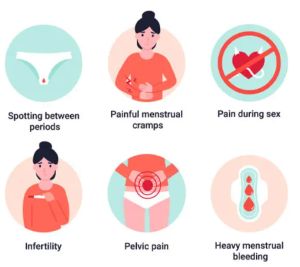If you have been experiencing chronic pelvic pain, especially before and during your menstrual period, you may be suffering from endometriosis.
This often-overlooked medical condition occurs when the tissue that normally lines the inside of the uterus (endometrium) grows outside the uterus, causing pain, inflammation, and potential complications.
Dr. Adeyemi Okunowo, a renowned gynecologist at the Lagos University Teaching Hospital explains, “Endometriosis is a complex disorder that can cause endometrial tissue to grow on the ovaries, fallopian tubes, and even the bladder or rectum.

This misplaced tissue responds to hormonal changes throughout the menstrual cycle, leading to pain, scarring, and other symptoms.”
Prevalence and risk factors
Endometriosis affects approximately 10% of women in their reproductive years, with symptoms often appearing in the 30s and 40s.
While the exact cause is unknown, several factors may increase the risk of developing endometriosis, including:
• Family history of the condition
• Early onset of menstruation
• Short menstrual cycles
• Nulliparity (never having given birth)
• Certain reproductive tract abnormalities
Symptoms and complications
The most common symptom of endometriosis is pelvic pain, which can range from mild to severe and may worsen during menstrual periods. Other symptoms may include:
• Heavy or prolonged menstrual bleeding
• Pain during or after sexual intercourse
• Painful urination or bowel movements, especially during menstruation
• Gastrointestinal issues (diarrhea, constipation, nausea)
• Fatigue and chronic pain
• Infertility or difficulty conceiving
Real-life experience
Adanna, a 35-year-old banker from Lagos, shares her endometriosis journey: “For years, I suffered from debilitating cramps and heavy bleeding during my periods.
It wasn’t until I saw a specialist that I was diagnosed with endometriosis. With the right combination of medication and lifestyle changes, I’ve been able to manage my symptoms and greatly improve my quality of life.”
Diagnosis and treatment
Diagnosing endometriosis can be challenging, as symptoms may mimic other conditions. A comprehensive evaluation by a gynecologist may involve:
• Detailed medical history and physical examination
• Imaging tests like ultrasound or MRI
• Laparoscopy, a minimally invasive surgical procedure to visualize and biopsy endometrial tissue
Treatment options depend on the severity of the condition, the patient’s age, and their desire for future pregnancy.
Dr. Okunowo advises, “If you experience chronic pelvic pain or other symptoms suggestive of endometriosis, don’t hesitate to consult with a gynecologist. Early diagnosis and individualized treatment can help manage symptoms, prevent complications, and improve overall well-being.”
Coping and Support
Living with endometriosis can be physically and emotionally challenging. In addition to medical treatment, the following strategies may help:
• Joining a support group or connecting with others who have endometriosis
• Practicing stress-reduction techniques like meditation or yoga
• Maintaining a healthy lifestyle through regular exercise and a balanced diet
• Keeping a symptom diary to identify triggers and patterns
By raising awareness about endometriosis and its impact on women’s health, we can encourage more open discussions, timely diagnosis, and comprehensive support for those affected by this condition.
If you suspect you may have endometriosis, reach out to a healthcare provider for proper evaluation and care.
Remember, you are not alone in this journey, and effective management is possible with the right guidance and support.


